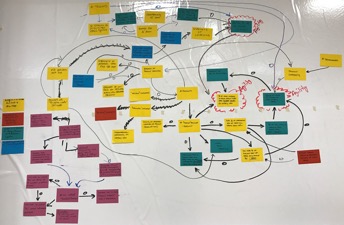In December, I had the opportunity to attend the Certified LeSS Practitioner course in New York City taught by Craig Larman, one of the co-founders of Large-Scale Scrum (LeSS). I’ll be sharing many learnings from the course in upcoming blogs, but to start, here are my top 5 takeaways.
A Quick Introduction to LeSS
Craig Larman and Bas Vodde developed LeSS to scale Scrum without losing its strength. Therefore, LeSS is based on one team Scrum and includes a set of principles and experiments, plus a framework with minimal rules. Many of the principles will appear familiar to those already acquainted with Scrum.

1. Simplify
At large scale, everything can appear overly complex and it may feel as if we need to create more structure to manage it. However, LeSS emphasizes simplifying and de-scaling wherever possible. Question whether you truly need more teams, larger teams, or more sites at all. In situations that require it, scale as simply as possible. LeSS intentionally limits the new roles, meetings, or process added to one team Scrum.
2. Lower the Cost of Change
What does being “Agile” really mean? It’s about flexibility; allowing you to easily make changes as new information is learned. In Craig’s words, it’s about being able to “turn on a dime, for a dime”.
To be agile at large scale and make change feasible, it becomes critical to significantly lower the cost of change. Consider whether the decisions you’re making ultimately increase or decrease the cost of change.
3. Optimize the Whole
Systems thinking was a big topic of the course. We explored how people have a cognitive bias towards local optimization, even though it results in system sub-optimization.
For example, people often believe that it’s more productive when one group specializes in a certain task, even if it ends up creating a bottleneck and ultimately slowing down delivery overall. Taking a systems view helps reveal how various parts influence each other and places the emphasis back on optimizing for the whole.
4. Use System Models
Because systems are often large and complex, it can be difficult to grasp how various elements impact one another. Creating system models is a great way to visualize system dynamics. Creating the model starts a conversation and eventually leads to shared understanding.

Look out for more on system models in an upcoming blog.
5. There are No Best Practices
LeSS, like Scrum, doesn’t prescribe a lot of specifics. Instead, the emphasis is on running experiments to determine what works best in your specific context. Within the minimal rules and the guidance provided by the principles, you have a lot of flexibility to discover what works.

And if you need help getting started, the LeSS Guides provide recommendations of experiments you may want to run, based on the founders’ experiences helping organizations adopt LeSS.
Summary
There are times when scaling is necessary, but the larger the system grows the harder it becomes to keep the whole system in view and to fight against the local optimization cognitive bias. By emphasizing simplicity and applying systems thinking, LeSS provides a way to maintain the goals of one team Scrum even as you move towards larger scale.
For more info, check out Larman and Vodde’s most recent book, Large-Scale Scrum, and upcoming Insights blog posts on LeSS Huge, systems modeling, and more!